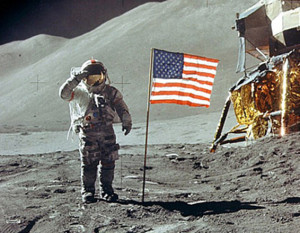By Chad Pillai.
This Sunday represents the 45th Anniversary of Astronaut Neil Armstrong setting foot on the moon and uttering his famous line: “One Small Step for Man, One Giant Leap for Mankind.” Since that monumental achievement, the U.S. Human Spaceflight Program has taken a giant leap backwards. Not only have we not achieved anything on the scale of the Apollo program since, but our human spaceflight program has regressed to a stage prior to “The Magnificent Seven” of the Mercury Program that first sent Astronaut Alan B. Shepard, Jr. into orbit with the retirement of the Shuttle Program. How did we find ourselves here? The answer is a lack of vision and funding.
NASA’s cut the Apollo program after Apollo 17 due to budgetary constraints and a growing lack of interests by the public to justify the program’s cost. Additionally, NASA needed to make funds available for the Space Shuttle Program. This is the point where NASA began to lose its ability to offer a vision for future human space exploration. The lesson NASA should have learned from the Apollo and the subsequent Space Shuttle Program is when the public and Congress lose interests due to the perceived “predictable routine” of the programs, it should have divested them into the commercial sector while it set its sights on deeper exploration. This would have allowed two things to occur: (1) allowed NASA to concentrate on riskier deep space exploration ventures only the government could fund; and (2) create the conditions for the commercial market to expand into space to reduce the cost of space exploration and travel.
NASA’s decisions to prematurely cancel the Space Shuttle Program before its new Orion Program was ready and lack of investment in heavy rocket motors since the Saturn V F-1 Engines have left the U.S. reliant on Russia to ferry our astronauts to the International Space Station (ISS) and lift critical national security assets into orbit with Russian supplied heavy rocket engines. Today, the U.S. Space Program is inadvertently vulnerable to U.S.-Russian Geo-Politics.
There is hope for our human space program. Recent competition by SpaceX and other startups such as Sierra Nevada to resupply the ISS is paving the way for commercialization. Other ventures such as Richard Branson’s Virgin Galactic along with key investors such as Google’s Jeff Bezos for commercial space flight will help break NASA’s stranglehold on low earth orbit flights for private and corporate consumers. If SpaceX is successful developing low cost reusable rockets, it will help reduce the stranglehold United Launch Alliance has on the market and create opportunities for future exploration and innovation. Finally, Congress’s recent approval to allow SpaceX to compete for Air Force space contracts will help reduce cost and create new opportunities.
Looking ahead, NASA needs to do the following to regain its prestige and help the Human Space Program take the next leap forward.
- Divest the low earth orbit business model by allowing private ventures such as SpaceX to service ISS, repair satellites, and conduct research on behalf the Government, Corporations, and etc.
- Gain authorization to establish regulatory guidelines for commercial space flight along the lines of the FAA. This will allow corporations to compete for this lucrative market for the likes of Richard Branson’s Virgin Galactic as it did for the likes of Howard Hughes in the Commercial Airline industry.
- Return to the Moon and establish a permanent station for further research, potential future moon mining, and as a launch pad for deep space exploration.
- Focus the majority of NASA’s budget on deep space exploration (Human and Robotic) for a future Mars Mission and beyond. Once a particular program becomes routine like the Shuttle Program, find ways to divest it to the commercial sector. This is how true Public-Private Partnership should work!
- Invest in domestic rocket engine production. This should be considered a national security asset for civilian and military application.
Our current human space program has been on the decline since Apollo 11 landed on the moon 45 years ago. Congress will not provide more funding for NASA in today’s hyper-partisan political atmosphere along with economic constraints; however, it can help NASA by providing flexibility to change its business model. NASA itself needs to develop a new vision for the human space program which recreates the enthusiasm of our Space Program of the 1960s while creating the incentives for the commercial market to be actively involved by appealing to their profit-driven self interests. Unless NASA, and to some degree the U.S. Air Force, doesn’t change their current business model, our Human Space Flight Program will continue to take a huge step backwards while future competitors such as Russia, China, India and others will leap ahead. Do we want to see other flags beside ours on the moon? If we don’t, we need change.



